Sir John B. Gurdon
Biographical
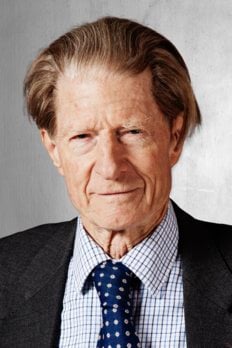
Family Background
John Bertrand Gurdon (JBG), born 2 October 1933, was brought up in a comfortable home by his parents (fig.1) on the Surrey/Hampshire border in a village, Frensham in South England, endowed with a large amount of National Trust heathland and ponds. His mother, Marjorie Byass, was from an East Yorkshire farming family. Brought up on a farm, and educated in that region, she became a physical training teacher working for some time in an American private school. When her son and daughter (Caroline, who trained as a nurse) had been raised, she gave much time to the regional administration of the “Women’s Institute,” a voluntary organisation for educating women.
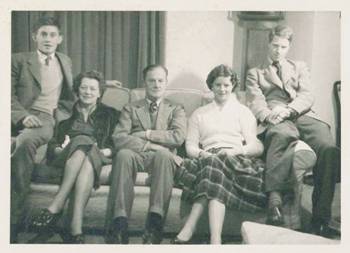
His father, William Gurdon, was from a longstanding Suffolk family whose ancestors go back to 1199 (fig. 2; Muskett, 1900; Cunnington, 2008); with the family motto “virtus viget in arduis” [virtue flourishes in adversity].
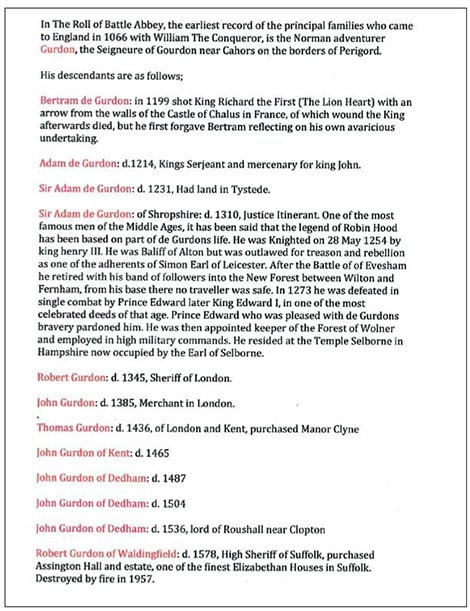
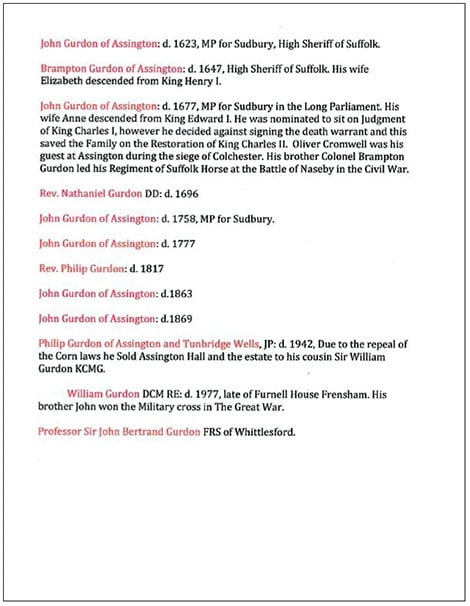
Many of them had distinguished careers in government and as regional administrators, including Sir Adam Gurdon [Muskett, 1900]. JBG’s ancestors lived in a stately home, Assington Hall, in West Suffolk (fig. 3).
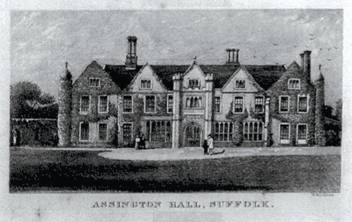
His grandfather had to leave the family home through lack of money to maintain it, due to repeal of the Corn Laws (1846) so that tenant farmers could no longer pay their rent, because of foreign imports. Assington Hall was requisitioned by the army during World War II, and was burnt down in a supposedly accidental fire in 1957. The remaining part of the house was partly restored and part of the original home, including its minarets, is still present in Assington. One of JBG’s ancestors married again after his first wife died and the outcome of a second marriage yielded a distinguished lawyer who accepted the hereditary title of Baron Cranworth. JBG’s father left school at the age of 16 and took a position in a rice broking firm in Burma. He was an early volunteer in the First World War and was decorated with the Distinguished Conduct Medal (DCM) before being commissioned to an officer rank. After that he led a career in banking in Assam and East India. He retired, in his forties, and in retirement, he gave much time to the transcribing of professional textbooks (especially legal) into Braille for the blind as voluntary work.
World War II started in 1939 when JBG was aged six. It was a time of austerity. Limited rations of food were managed by his mother, and the garden was used to raise chickens. He did not see luxuries like a banana or an orange until well after the end of the war. At the age of eight he was sent to a local private school, Frensham Heights. In an intelligence test at that age, he was asked to draw an orange. He started drawing the stalk by which the orange would hang from a tree, reasoning that an orange would not exist in space. The teacher tore up the piece of paper and reported to his parents that he was mentally subnormal and would need special teaching. The teacher meant to say, draw a circle. He was moved to another private school in the village, namely Edgeborough, where he thrived. At that age he had an intense interest in plants and insects. In most of his spare time he collected butterflies and moths and raised their caterpillars.
Education
At the age of 13, he started school at Eton as a boarder. He found life there intensely uncomfortable, because senior boys acted as despots, administering punishments for trivial misdemeanours. As a means of survival, he took up squash, and as a result of hard work rather than ability, he became eventually the school captain in this sport. While at school he continued his interest in Lepidoptera, raising large numbers of moths from their larval stage.
It was during his first term of being taught Science at the school, at the age of 15, that he received a totally damning report from the Biology master (fig. 4). This report resulted from JBG being placed in the bottom position of the lowest form in a group of 250 students of the same age. The report, sent to his housemaster, resulted in him being taken off any further study of Science of any kind at the school. For the rest of his school days, for the next three years, he was given no Science teaching and was placed in a class which studied Ancient Greek, Latin and a modern language, a course intended for those judged to be unsuited for studying any subject in depth.
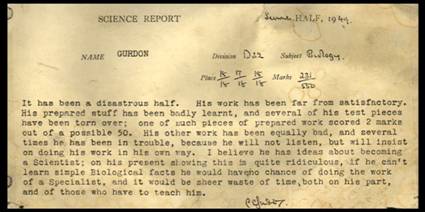
Entrance to University was a problem: having sat the Entrance examination in Latin and Greek, the Admissions tutor at Christ Church Oxford University told JBG that he would be accepted for Entrance on condition that he did not plan to study the subject in which he took the Entrance (Classics). Later the Admissions tutor admitted that he had under-filled the college and had his mind on other things; he was Hugh Trevor-Roper, later Lord Dacre, and author of The Last Days of Hitler. In due course it emerged that JBG’s acceptance for Christ Church involved a complicated arrangement between JBG’s uncle, at that time a Fellow of Christ Church, JBG’s school housemaster and a friend of his uncle, Sir John Masterman, who was Master of Worcester College, Oxford and in charge of the wartime Enigma operation at Bletchley, agreeing to accept the housemaster’s son. Such a manoeuvre, and admission to Oxford on those terms, could never happen now. At that time, 1952, it was not very easy to fill a college with paying students. Before entering University, JBG had to take a year off to learn elementary Biology with a private tutor, generously funded by his parents who had already paid several years of Eton fees. He was told that he could formally enter the Department of Zoology course at Oxford if he passed the elementary exams in Physics, Chemistry and Biology in a preliminary year. He survived this and started the course in Zoology at Oxford in 1953. The course was extremely oldfashioned, by today’s standards. A major part of the teaching involved learning Palaeontology, and the names of skeletal parts of dinosaurs. JBG later became a personal friend of Sir Alister Hardy, the Head of that department, through his Oxford aunt (see later).
Graduate Student Work
As the Zoology course came to an end, JBG enquired about the possibility of doing a PhD in Entomology, in accord with his continuing interest in insects. While still a student, he had got permission to go to Oxford University’s nature reserve, namely Wytham Woods, with his butterfly net. No butterflies were to be seen, but he caught the only moving thing, which was a kind of fly. He used the taxonomic reference works to try to identify this “fly.” Having realised that the fly was a Hymenopteron, he was still unable to identify it. He therefore went to the Natural History Museum in London for help. They pronounced that it was in fact a species of sawfly new to Britain. This must have been intensely irritating to the Professor of Entomology, whose main research project was to identify animals and plants in Wytham Woods. JBG was later rejected for PhD work in Entomology. This was a great blessing because the work he would have done in Entomology was not well regarded and had very little, if any, analytical component to it. By his immense good fortune, he was invited to do a PhD with the Oxford University lecturer who taught Developmental Biology, Dr Michael Fischberg.
Fischberg was born in St Petersburg, Russia, in 1919. He was educated in Switzerland and was a PhD student of E. Hadorn. Hadorn in turn was a student of F. Baltzer, who was a student of H. Spemann, himself a student of T. Boveri. This German-Swiss lineage of eminent Developmental Biologists turns out to be the background of a great many of the successful Developmental Biologists of the mid-1950s. Most of those that did not have this background can trace their own training back to R. G. Harrison (1870–1959) of the USA, who pioneered cell culture. Having finished his PhD with Hadorn, Fischberg took a position in the Institute of Animal Genetics under Waddington in Edinburgh, from where he accepted his appointment in the Oxford Zoology department, headed by Professor Sir Alister Hardy, an eminent marine biologist [Royal Society memoirs].
Starting his PhD work in 1956, Fischberg suggested to JBG that he should try to carry out somatic cell nuclear transfer in Xenopus, a procedure for this having been recently published by Briggs and King (1952). The advisability and technical problems that arose at this point are described in the accompanying papers (Gurdon 2013 a,b). Once these technical obstacles had been overcome, largely as a result of good luck, JBG’s work proceeded extraordinarily fast; strongly motivated by early success, he became an intensely hard worker. By the end of his PhD he had succeeded in obtaining normal development of intestinal epithelium cell nuclei transplanted to enucleated eggs of Xenopus. When these tadpoles had eventually reached sexual maturity, he was able to publish a paper entitled “Fertile intestine nuclei.”This was the first decisive evidence that all cells of the body contain the same complete set of genes. This answered a long-standing and important question in the field of Developmental Biology. However it also showed very clearly, as was commented on in JBG’s papers at the time, the remarkable ability of eggs to reprogram somatic cell nuclei back to an embryonic state. Eventually this phenomenon attracted increasingly large interest, and led to the idea of cell replacement using accessible adult cells, such as skin. A key future discovery was that of Martin Evans (Nobel Prize, 2006) that a permanently proliferating embryonic stem cell line could be established from mouse embryos. Under appropriate conditions these cells could be caused to differentiate into all different cell types. The combination of somatic cell nuclear transfer and the derivation of embryonic stem cells in mammals made it realistic to think of cell replacement for human diseases. A huge boost for this idea was later provided by Takahashi and Yamanaka (2006), with their discovery that the overexpression of certain transcription factors can also yield embryonic stem cells from adult somatic tissue. The accompanying Nobel lecture provides more detail of the later scientific part of JBG’s career.
Post-Doctoral Work
A visit by the Nobel Laureate George Beadle to the Fischberg Group in the Oxford Zoology department in 1960 led to an offer from the California Institute of Technology (CalTech) (previous chairman George Beadle) for JBG to do postdoctoral work there. Fischberg very wisely advised JBG to accept the CalTech offer of postdoctoral work rather than offers from other nuclear transplant labs. Stimulated by his mother’s adventurous spirit, JBG decided to buy a secondhand Chevrolet in New York and drive across the USA to California, using the famous Route 66 (now replaced). He gave lectures as he travelled across the USA and stopped at laboratories of Briggs and King, Alexander Brink (paramutation) etc. He had hoped to become a post-doctoral student of R. Dulbecco at CalTech (Nobel Prize), but the chairman of that department advised against this because JBG had no training in virology. Therefore JBG did his postdoctoral work with Robert Edgar on Bacteriophage Genetics. JBG found he had no aptitude at all for Phage Genetics and decided to return to Britain after one year at CalTech. Nevertheless, that year at CalTech was extremely formative because it provided some acquaintance with Molecular Biology, which had so far entirely escaped his training. During that year he met Sturtevant, a student of Morgan, who pioneered the whole field of Drosophila Genetics. He also got to know Ed Lewis (future Nobel Laureate). Thanks to James Ebert (director of the Department of Embryology, Carnegie Institute of Washington, in Baltimore) JBG visited various labs in the USA at the end of his post-doctoral period and met Donald Brown in Baltimore on that visit. Meantime, the success of the nuclear transfer work in Oxford had led to Michael Fischberg being offered a head of department professorship in Geneva, Switzerland. JBG was offered the teaching position in Oxford vacated by M. Fischberg. JBG returned from California to England via Japan and many other countries over a two-month period. One month of that time he spent in Japan and met Tokindo Okada and made other friends in Japan, including M. Furusawa and subsequently Koichiro Shiokawa.
While doing graduate and postdoctoral work in Oxford, JBG made other contacts and friendships. His mother’s sister lived in Oxford, and he spent much time at her house and visiting famous gardens, fostering a lifelong interest in plants. Through that connection he met Miriam Rothschild, and became a lifelong friend of hers (Van Emden and Gurdon, 2006). This friendship contained, through Miriam Rothschild’s generosity, ski mountaineering holidays based in her house in Wengen. JBG had achieved the British ski club’s Gold standard ski medal, again through relentless practice rather than any natural ability. Also, in accord with his interest in the open air and dogged determination, he became a reasonably accomplished ice figure skater.
Assistant Lectureship in Oxford, Department of Zoology
On starting the job, JBG was immediately asked to do 24 lectures on Development. From then on his allocation of student lecturing duties went down progressively during his career until, in the end, he was only asked to do two such lectures per year. But the lectures seemed to go well because he attracted, almost immediately, some of the best students to do PhD work with him. Notable among these were C.F. Graham (later FRS) and R.A. Laskey (later FRS, Royal Medal and CBE). During his time in Oxford when he started his own research group, he was able to interact with many very senior scientists in other departments, notably R. R. Porter (Nobel), H. Harris and J. L. Gowans.
On return to Oxford, as an Assistant Lecturer in the Zoology department JBG was accorded a privileged position, at his Oxford College Christ Church, as a Research Fellow. He was given only minimal teaching duties, so that he could establish his own research group. At that time, he was fortunate to meet his future wife (fig. 5), Jean Elizabeth Margaret Curtis, eldest daughter of Mr H.J. Curtis who owned a successful business in Oxford in property and gravel. With his wife he had two children; his daughter Aurea has two of her own children. His son, William, did not marry and has no issue.
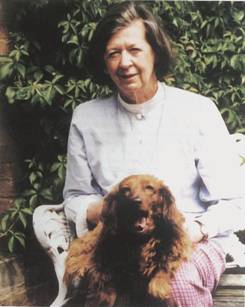
At fi he lived with his wife and children in a brew-house in Christ Church Oxford (fi . 6), then in a house they had built in his father-in-law’s land.
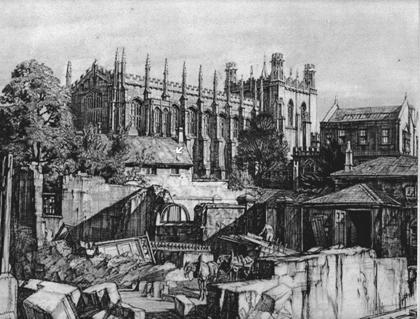
At this time he made, with his father-in-law, a crossing under the town of Oxford in a disused drain, the Trill Mill underground stream – now permanently closed (fi . 7).
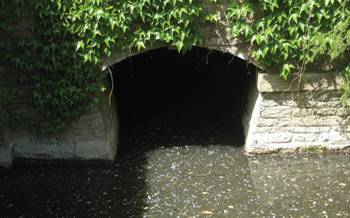
On moving to Cambridge, he was able to acquire, largely through a successful property business of his wife, a large property with a 16th century house in the village of Whittlesford (fig. 8).
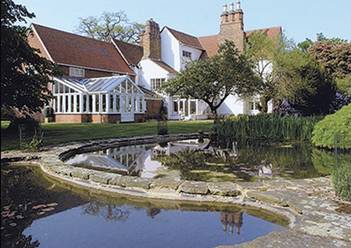
Career Moves
After nearly ten years (then 1972) as lecturer in the Zoology department, Oxford, JBG was given a very generous research grant by the MRC of four positions (3 Sci + 1 Tech). At the same time, Max Perutz of Cambridge MRC Molecular Biology lab offered him a position. Max Perutz had empty space that had (by MRC rules) to be filled externally. JBG accepted, and planned to move to Cambridge, very reluctantly by his wife because of our house and her family in Oxford). But senior professors in Oxford persuaded him to decline the offer, notably Rodney Porter (Biochemistry), James Gowan and H. Harris (Pathology). They tried hard to persuade his own (Zoology) Professor Pringle to give JBG the space needed for a now enlarging MRC “unit.” But JBG said he could not manage with the very dispersed space offered. So JBG (eventually) accepted Max Perutz’s offer, and moved to Cambridge LMB. After a few years, Rodney Porter (Biochemistry) offered JBG the Chair of Genetics in Oxford, a sub-department of Biochemistry, a position vacated by Professor Bodmer. By then JBG’s wife and family were very settled in Cambridge and they decided not to move back to Oxford.
Wellcome CRC Institute
After a further ten years (then 1982), Sir Gabriel Horn (Head of Zoology, Cambridge) offered JBG and Ronald Laskey professorships in his department. We both decided (RAL had by then also moved to LMB, Cambridge) to accept jobs in Zoology Cambridge, if they succeeded (as they did) in obtaining substantial support from the Cancer Research Campaign for a joint “unit” in Zoology, Cambridge. They were accommodated, very generously, by Professor Horn, in Zoology, Cambridge. At this time the Wellcome Trust had, thanks to Sir Roger Gibbs, become a major national funding agency. Ron Laskey and JBG were encouraged by the Wellcome Trust to bid for a small Institute to be built in Cambridge for their”unit” and to accommodate some other scientists. It was agreed that the Wellcome Trust and CRC would jointly fund an Institute costing £4M to include some two groups and four others for which we chose: Martin Evans, Janet and Chris Wyllie and Michael Akam. A new building was designed by Laskey and Akam, and they decided, generously, to have JBG as Chairman. We attempted to follow the administrative style of Max Perutz, whose LMB was widely regarded as the most successful research institute internationally. Our Institute thrived, and most particularly because Gabriel Horn, extremely generously, made our new Institute independent of his Zoology department. This arose, importantly by proposing that Group Leaders in our Institute should be affiliated with several different departments in Cambridge, and not all with Zoology. Their new appointments included Azim Surani, Daniel St Johnston, Steve Jackson and Tony Kouzarides (all later FRS). In the 1990s, the Institute had the chance to bid for a new building and more space. They were awarded a Wellcome Trust and CRUK building (£23M), located next to the new Biochemistry department in Cambridge (now 2000).
JBG was succeeded as Chairman by Jim Smith, and then, by Daniel St Johnston. By 2012 the Institute had 17 Group Leaders and had been joined by Anne McLaren. Its tally: one Dame, two Knights, two Nobels, four CBEs, eight FRS, importantly four home-grown.
Cambridge College Appointments
Soon after moving from Oxford to Cambridge in 1971 JBG was offered, on the recommendation of Professor Richard Keynes, a research fellowship at Churchill College. With no obligatory teaching duties, this was a very appealing college connection. Being a large college with over 100 fellows, this was a very welcome opportunity to meet a wide range of Cambridge academics. In 1985 JBG was offered by Lord Braybrooke, the College Visitor, the Mastership of Magdalene College. He accepted this position and this was a major blessing. Compared to two other colleges for which he had been unsuccessfully interviewed, Magdalene accepted that he would wish to keep his laboratory activities going while acting as Master of the College. He chose to decline the usual emolument of a Master so that it could be used to hire a professional fundraiser, thereby releasing JBG for his own laboratory work. The college required only minimal time and spared him much of the committee work normally expected. His wife took to the Master’s wife job like a duck to water. She chose to entertain every undergraduate, every year, in the college to a sit-down Sunday lunch prepared and cooked by herself. She invited 20 students to lunch every Sunday in term. She got to know all the staff in the college and her complete involvement was enormously appreciated. With no internal frictions that he was aware of, the college seemed a happy place and a privileged existence for JBG and his family.
For other administrative jobs for which JBG had been proposed, fortunately he was not selected. In retrospect, any of these would have destroyed his remaining research career. He did however serve for 15 years as a Fellow (Governor) of Eton College where he met some outstanding individuals, including most notably Sir John Smith, the founder of the Landmark Trust, and also a benefactor to JBG’s research. JBG also served for a long time on the Cancer Research Campaign (subsequently CRUK) research grant committee. Compared to many others this committee was very well run and promoted a very happy relationship among its members. This connection opened the door for eventual funding by the CRC/Wellcome Trust for a new Institute for him and his colleague Ron Laskey in Cambridge. JBG also served for a few years as a “Governor”(Board member) of the Wellcome Trust, under the chairmanship of Sir Roger Gibbs, who, as it later turned out, had in earlier years almost as undistinguished career as JBG at the same school.
Other Activities
JBG sees himself as the ultimate non-intellectual. He prefers to do things himself rather than watch others. He never goes to the theatre or musical performances, and hates reading books. With the time thereby saved, he likes to take exercise, in earlier years through skiing and squash (later tennis). Throughout life he has travelled widely, with a special interest in going up mountains and seeing alpine plants. He has been to the top of many of the 14,000ers in Colorado, USA, the highest point in New Guinea, etc.
References
Muskett, J.J. (1900), Suffolk Manorial Families, Wm Pollard & Co., Ltd, North Street, Exeter. Cunnington, B. (2008), The Gurdon Family, Cunnington, Bronwen. Beechwater, Australia, 3747.
Briggs, R. & King T.J. (1952),”Transplantation of living nuclei from blastula cells into enucleated frogs’ eggs.” Proc. Nat. Acad. Sci. 38:4 55–463.
Van Emden, H.F. and Gurdon J.B. (2006), “Dame Miriam Louisa Rothschild CBE 5 August 1908–20 January 2005.” Biogr. Mems Fell. R. Soc. 52: 315–330.
Gurdon, J.B. (2013a),”The egg and the nucleus: A battle for supremacy.”Development, 140: 2449–2456.
Gurdon, J.B. (2013b) “The cloning of a frog.” Development, 140: 2446–2448.
Takahashi, K. & Yamanaka S. (2006) “Induction of pluripotent stem cells from mouse embryonic and adult fibroblast cultures by defined factors.” Cell 126: 663–676.
This autobiography/biography was written at the time of the award and later published in the book series Les Prix Nobel/ Nobel Lectures/The Nobel Prizes. The information is sometimes updated with an addendum submitted by the Laureate.
Nobel Prizes and laureates
Six prizes were awarded for achievements that have conferred the greatest benefit to humankind. The 12 laureates' work and discoveries range from proteins' structures and machine learning to fighting for a world free of nuclear weapons.
See them all presented here.
